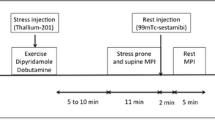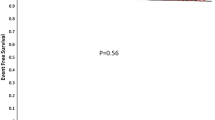Abstract
Safety of performing adenosine myocardial perfusion stress testing as early as 24 h after acute uncomplicated myocardial infarction is not known. We evaluated 31 (14 females and 17 males, average age 72, range 46–89 years) consecutive patients with uncomplicated myocardial infarction, who underwent adenosine myocardial perfusion stress imaging, 24–72 h after infarction for risk stratification. Adenosine was infused at a rate of 140 μg/kg/min for 6 min. Twenty patients were presented with non-ST-elevation myocardial infarction. Eleven patients were admitted with acute ST-elevation myocardial infarction. Patients were monitored for signs of complication during and immediately after the stress test. The average time from admission to performance of stress tests was 51 ± 19 h, ranging from the minimum of 24 h to maximum 72 h. No complications related to adenosine infusion were detected. In conclusion, our data suggest that a further large study of early adenosine myocardial perfusion SPECT imaging may be safe in a carefully selected group of patients after uncomplicated myocardial infarction.
Similar content being viewed by others
References
Braunwald E, Antman EM, RO, Smith SC Jr, et al. ACC/AHA guidelines for the management of patients with unstable angina and non-ST-segment elevation myocardial infarction. (Committee on the Management of Patients With Unstable Angina). J Am Coll Cardiol 2000; 36(3): 970–1062.
Boden WE, O'Rourke RA, Crawford MH, et al. Outcomes in patients with acute non-Q-wave myocardial infarction randomly assigned to an invasive as compared with a conservative management strategy. Veterans Affairs Non-Q-Wave Infarction Strategies in Hospital (VANQWISH) Trial Investigators. N Engl J Med 1998; 338(25): 1785–1792.
Cerqueira MD, Verani MS, Iskandrian AS, et al. Safety profile of adenosine stress perfusion imaging: results from the adenoscan multicenter trial registry. J Am Coll Cardiol 1994; 23(2): 384–389.
Samuels B, Kiat H, Friedman JD, Berman DS. Adenosine pharmacologic stress myocardial perfusion tomographic imaging in patients with significant aortic stenosis. Diagnostic efficacy and comparison of clinical, hemodynamic and electrocardiographic variables with 100 age-matched control subjects. J Am Coll Cardiol 1995; 25(1): 99–106.
Mahaffey KW, Puma JA, Granger CB, et al. Adenosine as an adjunct to thrombolytic therapy for acute myocardial infarction: results of a multicenter, randomized, placebo-controlled trial: the acute myocardial infarction study of adenosine (AMISTAD) trial. J Am Coll Cardiol 1999; 34(6): 1711–1720.
Effects of tissue plasminogen activator and a comparison of early invasive and conservative strategies in unstable angina and non-Q-wave myocardial infarction. Results of the TIMI IIIB Trial Circulation 1994; 89(4): 1545–1556.
Brown KA, Beller GA, Haber SB, et al. Early dipyridamole (99m) Tc-sestamibi single photon emission computed tomographic imaging 2 to 4 days after an acute myocardial infarction predicts in-hospital and post-discharge cardiac events: comparison with submaximal exercise imaging. Circulation 1999; 100(20): 2060–2066.
Braunwald. Myocardial Perfusion Imaging Heart Disease: A Textbook of Cardiovascular Medicine, 5th ed. Philadelphia: W.B. Saunders Company, 1998.
Moser GH, Schrader J, Deussen A. Turnover of adenosine in plasma of human and dog blood. Am J Physiol 1989; 256(4 Pt 1): C799–C806.
Mahmarian JJ, Pratt CM, Nishimura S, Abreu A, Verani MS. Quantitative adenosine 201Tl single-photon emission computed tomography for the early assessment of patients surviving acute myocardial infarction. Circulation 1993; 87(4): 1197–1210.
Bouvier F, Hojer J, Hulting J, Ruiz H, Samad B, Jensen-Urstad M. Myocardial perfusion scintigraphy single photon emission computer tomography during adenosine stress can be performed safely early on after thrombolytic therapy in acute myocardial infarction. Clin Physiol 1998; 18(2): 97–101.
Heller GV, Brown KA, Landin RJ, Haber SB. Safety of early intravenous dipyridamole technetium 99m sestamibi SPECT myocardial perfusion imaging after uncomplicated first myocardial infarction. Am Heart J 1997; 134: 105–111.
Author information
Authors and Affiliations
Rights and permissions
About this article
Cite this article
Kulhanek, J., Sorrell, V.L., Ershadi, R.E. et al. Adenosine myocardial perfusion single photon emission computed tomographic stress testing 24–72 h after uncomplicated myocardial infarction. Int J Cardiovasc Imaging 18, 269–272 (2002). https://doi.org/10.1023/A:1015525311510
Issue Date:
DOI: https://doi.org/10.1023/A:1015525311510




